Genshin may refer to:
Genshin may refer to:
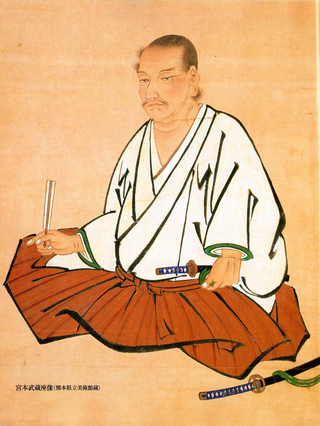
Miyamoto Musashi, born Shinmen Takezō, also known as Miyamoto Bennosuke and by his Buddhist name, Niten Dōraku, was a Japanese swordsman, strategist, artist, and writer who became renowned through stories of his unique double-bladed swordsmanship and undefeated record in his 62 duels. Musashi is considered a kensei of Japan. He was the founder of the Niten Ichi-ryū, or Nito Ichi-ryū, style of swordsmanship, and in his final years authored The Book of Five Rings and Dokkōdō.

Usagi Yojimbo is a comic book series created by Stan Sakai. It is set primarily at the beginning of the Edo period of Japanese history and features anthropomorphic animals replacing humans. The main character is a rabbit rōnin, Miyamoto Usagi, whom Sakai based partially on the famous swordsman Miyamoto Musashi. Usagi wanders the land on a musha shugyō, occasionally selling his services as a bodyguard.

Sasaki Kojirō was a Japanese swordsman who may have lived during the Azuchi–Momoyama and early Edo periods and is known primarily for the story of his duel with Miyamoto Musashi in 1612, where Sasaki was killed. Although suffering from defeat as well as death at the hands of Musashi, he is a revered and respected warrior in Japanese history and culture. Later Miyamoto proclaimed that Sasaki Kojirō was the strongest opponent he faced in his life.
Musashi (武蔵) is a Japanese name, which may refer to:
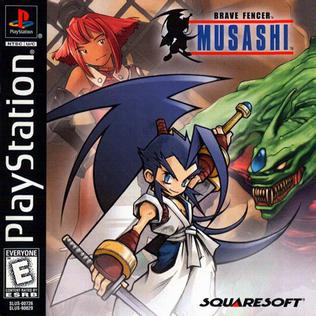
Brave Fencer Musashi is an action role-playing video game developed and published by Square in 1998 for the PlayStation home console. The game involves real-time sword-based combat in a 3D environment; it also features segments of voiced over dialogue and role-playing game elements such as a day-night cycle and resting to restore energy.
Miyamoto is a Japanese surname. Notable people with the surname include:
A samurai is a member of the Japanese warrior caste.

Shinobi is a series of hack-and-slash games created by Sega. The ninja (shinobi) Joe Musashi is the protagonist of the original series of games. The first Shinobi was released in 1987 as an arcade video game. Along with Alex Kidd and Sonic the Hedgehog, Joe Musashi has long been one of Sega's flagship characters, acting as a mascot for a short time in the late 1980s when ninjas were popular in mainstream media. The series' games are a showcase of Sega's technical accomplishment, noted for their high quality of graphics, gameplay and music, as well as their high level of difficulty. The Shinobi franchise sold more than 4.60 million copies.
This is a list of fictional depictions of Miyamoto Musashi, a 17th-century Japanese swordsman.
Musashi Gundoh is a Japanese anime television series, based on an unused story by Monkey Punch. It premiered in Japan on the satellite station BS-i on April 9, 2006, and was also set to be broadcast across Japan by the anime satellite television network Animax from October 2006. It is also legally distributed over the Internet by GyaO from May 13, 2006. According to the producer, there were originally plans to broadcast the anime overseas, but they were scrapped due to poor reception of the anime.

Ninja Gaiden II is a 2008 action adventure hack and slash game developed by Team Ninja and published by Microsoft Game Studios for the Xbox 360. It is the sequel to the 2004 title Ninja Gaiden, making it the second 3D title in the series of the same name, and was released worldwide in June 2008. A reimagined and heavily altered version, titled Ninja Gaiden Sigma 2 was released for the PlayStation 3 later in 2009, and was published by Tecmo Koei, followed by Ninja Gaiden Sigma 2 Plus for the PlayStation Vita in 2013.
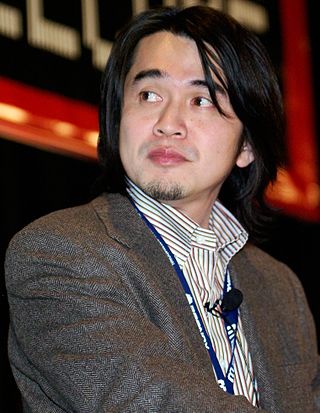
Yoshiaki Koizumi is a Japanese video game designer, director, producer, and business executive. He is a senior executive officer at Nintendo and a deputy general manager at Nintendo EPD, where he is known for his work within their Mario and The Legend of Zelda series, and as the General Producer of the Nintendo Switch. In 2009, he was chosen by IGN as one of the top 100 game creators of all time.
Furuhashi Sōzaemon was a Japanese samurai of the early Edo period. Famed for his skill in swordsmanship. Sōzaemon, along with both Terao Magonojo, and his younger brother Terao Motomenosuke would be the legendary Miyamoto Musashi's three chosen successors. After their master's death, Sōzaemon had borrowed Magonojo's Gorin no sho for a few days, in which he made a copy of this book and gave it to Lord Hosokawa Mitsuhisa through his orders. Furuhashi himself would also make another copy of the book which was later transmitted to his disciples, which went by the name of Ihon gorin no sho. The following copy ends with this notice:
Kojirō, Kojiro, Koujirou or Kohjiroh is a masculine Japanese given name. Notable people with the name include:

Shinobu (しのぶ) is a Japanese verb meaning "recall" (偲ぶ) or "stealth/endure" (忍ぶ). It is a Japanese given name used by either sex. Shinobu is also the dictionary form of shinobi, which can be combined with mono (者) to make shinobi no mono (忍びの者), an alternative name of ninja.
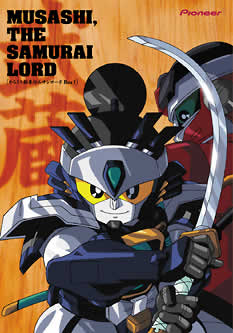
Musashi, the Samurai Lord, known in Japanese as Karakuri Kengō Den Musashi Lord, is an anime series by Studio Pierrot. The 50-episode series aired on Nippon Television from October 1990 to September 1991.
The Edo period of the history of Japan is the setting of many works of popular culture. These include novels, stage plays, films, television shows, animated works, manga, and video games. Major events of the period, such as the Siege of Osaka, Shimabara Rebellion, and the decline and fall of the Tokugawa shogunate figure prominently in many works. Historical and fictional people and groups of the period, including Miyamoto Musashi, Izumo no Okuni, Yagyū Jūbei Mitsuyoshi, the fictional Isshin Tasuke, Yui Shōsetsu, Matsuo Bashō, Tokugawa Mitsukuni, Ōoka Tadasuke, Tōyama Kagemoto, the Forty-seven Ronin, Sakamoto Ryōma, Katsu Kaishū, and the Shinsengumi, as well as the fifteen Tokugawa shoguns were active for much or all of their public lives and are dramatized in works of popular culture. The cultural developments of the times, including kabuki, bunraku, and ukiyo-e, and practices like sankin kōtai and pilgrimages to the Ise Shrine, feature in many works set in Edo Japan.
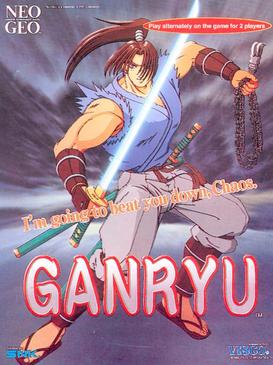
Ganryu is a 1999 side-scrolling hack and slash action-platform arcade video game developed and originally published by Visco Corporation exclusively for the Neo Geo MVS. It is loosely based upon the battle of Japanese swordsman Miyamoto Musashi on Ganryū-jima island against Sasaki Kojirō, who is also known as Sasaki Ganryū, hence the reasons for the abbreviated name of the game. In the game, players assume the role of either Musashi or Suzume on a journey to defeat a resurrected Kojirō and his legion of evil ninjas and monsters terrorizing Kyoto. A sequel, titled Ganryu 2: Hakuma Kojiro, was developed Storybird Studio and published by Just for Games and PixelHeart. It was released in April 2022 to generally mixed reception.

Genshin Impact is an action role-playing game developed and published by miHoYo. It was released for Android, iOS, PlayStation 4, and Windows in 2020, and for PlayStation 5 in 2021, with an Xbox Series X/S version coming in November 2024. The game features an anime-style open world environment and an action-based battle system using elemental magic and character-switching. A free-to-play game monetized through gacha game mechanics, Genshin Impact is updated regularly using the games as a service model.
源信 may refer to: